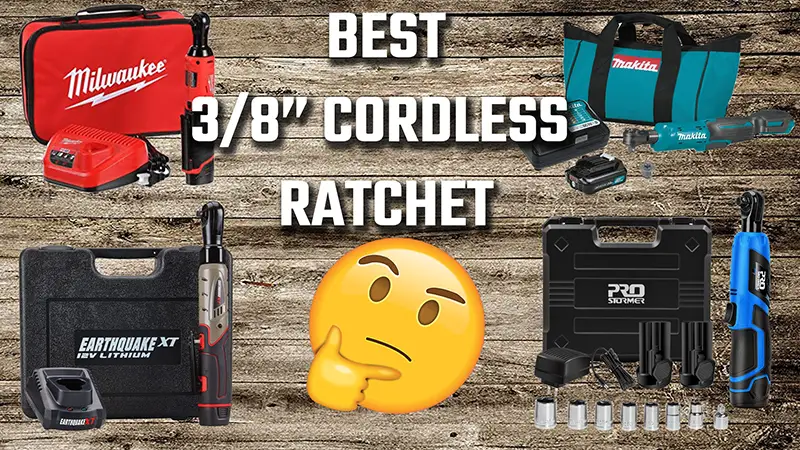
For a lot of people, a 3/8-inch cordless ratchet is a must-have tool. The least expensive brand we’ll be testing is only 60 dollars, compared to Makita which is $189. So, the question is, is that Makita really worth an extra $129? We’ll see which ratchet offers the highest rpm. We’ll test the ratchets for maximum torque. We’ll see which ratchet can handle a constant load for 30 seconds.
CollegeDormEssentials.com is a participant in the Amazon Services LLC Associates Program, an affiliate advertising program designed to provide a means for sites to earn advertising fees by advertising and linking to Amazon.com
Pro Stormer
 At a price of only $59.99, is this Pro Stormer brand. It claims to be a very light tool at only 1.85 pounds, two thousand milliamp hour battery. All the ratchets we’ll be testing are powered by 12 volts. The Pro Stormer comes with a second battery. Battery charger delivers up to 30-foot pounds of torque, superior fastening speed with 230 rpm, LED indicator provides you with real-time battery level at all times. The Pro Stormer even comes with several sockets, made in China. The Pro Stormer is really light, at only one pound, 13.7 ounces, 843 grams. The balance of a tool is always a factor to consider. At the very front of this tool has 472 grams, the back of it 372 grams. The Pro Stormer is actually a fairly balanced tool with 56% of the weight on the ratchet end of the tool and 44% on the handle end. I’m going to place the sound meter 24 inches from the ratchet so we can compare the noise levels, and the Pro Stormer is very close to 81 decibels. The Pro Stormer definitely has a compact head at only 36.91 millimeters front to back, and 30.37 millimeters from side to side.
At a price of only $59.99, is this Pro Stormer brand. It claims to be a very light tool at only 1.85 pounds, two thousand milliamp hour battery. All the ratchets we’ll be testing are powered by 12 volts. The Pro Stormer comes with a second battery. Battery charger delivers up to 30-foot pounds of torque, superior fastening speed with 230 rpm, LED indicator provides you with real-time battery level at all times. The Pro Stormer even comes with several sockets, made in China. The Pro Stormer is really light, at only one pound, 13.7 ounces, 843 grams. The balance of a tool is always a factor to consider. At the very front of this tool has 472 grams, the back of it 372 grams. The Pro Stormer is actually a fairly balanced tool with 56% of the weight on the ratchet end of the tool and 44% on the handle end. I’m going to place the sound meter 24 inches from the ratchet so we can compare the noise levels, and the Pro Stormer is very close to 81 decibels. The Pro Stormer definitely has a compact head at only 36.91 millimeters front to back, and 30.37 millimeters from side to side.
Earthquake XT
 At $99.99, the second least expensive brand we’ll be testing is the Earthquake XT which is sold at Harbor Freight. 60-foot pounds of torque, delivers the power of air, 2-amp hour high-capacity battery. It comes with a 12-volt charger variable speed paddle with electronic brake for control and versatility compact head designed for use in tight spaces, variable speed 0 to 170 rpm, we’re going to test that. The Pro Stormer came with two batteries, the Earthquake only comes with one battery charger. Compared to the Pro Stormer, there’s quite a bit of difference in size. The Earthquake is made in China. The Earthquake uses a variable speed paddle. Neither the Pro Stormer nor the Earthquake have a way to lock the tool out to keep it from accidentally activating inside of a toolbox if something comes in contact with the paddle or the trigger. The Earthquake is 1,352 grams, two pounds, and 15.7 ounces so just under three pounds for the Earthquake. 839 grams and 511 grams. So, the Earthquake isn’t quite as well balanced as a Pro Stormer, with 62% of the tool weight on the ratchet head side and 38% on the handle side. 86 decibels for the Earthquake so it’s quite a bit louder than the Pro Stormer. The Earthquake claims to have a compact head but is actually quite a bit larger than all the other brands measuring 43.28 millimeters front to back and 40.3 side to side.
At $99.99, the second least expensive brand we’ll be testing is the Earthquake XT which is sold at Harbor Freight. 60-foot pounds of torque, delivers the power of air, 2-amp hour high-capacity battery. It comes with a 12-volt charger variable speed paddle with electronic brake for control and versatility compact head designed for use in tight spaces, variable speed 0 to 170 rpm, we’re going to test that. The Pro Stormer came with two batteries, the Earthquake only comes with one battery charger. Compared to the Pro Stormer, there’s quite a bit of difference in size. The Earthquake is made in China. The Earthquake uses a variable speed paddle. Neither the Pro Stormer nor the Earthquake have a way to lock the tool out to keep it from accidentally activating inside of a toolbox if something comes in contact with the paddle or the trigger. The Earthquake is 1,352 grams, two pounds, and 15.7 ounces so just under three pounds for the Earthquake. 839 grams and 511 grams. So, the Earthquake isn’t quite as well balanced as a Pro Stormer, with 62% of the tool weight on the ratchet head side and 38% on the handle side. 86 decibels for the Earthquake so it’s quite a bit louder than the Pro Stormer. The Earthquake claims to have a compact head but is actually quite a bit larger than all the other brands measuring 43.28 millimeters front to back and 40.3 side to side.
MILWAUKEE
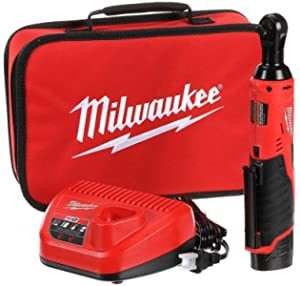 At $162 for the ratchet as well as the starter kit is this Milwaukee brand. 35-foot pounds of torque, 0 to 250 rpm, it only weighs 1.5 pounds. It’s only 10 and 3/4 inches in length. The Milwaukee is made in China. M12 charger, 2–4-amp hour batteries, made in Korea or Malaysia, with additional processing in China. The Milwaukee weighs 2 pounds, 6.2 ounces, 1083 grams. The Milwaukee does have a lockout feature which keeps the tool from powering up accidentally. 511 grams & 570 grams, so the Milwaukee is the best-balanced tool yet with 47% of the weight on the head side of the tool. At very close to 81 decibels, the Milwaukee and the Pro Stormer put out about the same amount of noise, 31.12 that’s the best yet. Only 29.66 mm, the Milwaukee has the most compact head design.
At $162 for the ratchet as well as the starter kit is this Milwaukee brand. 35-foot pounds of torque, 0 to 250 rpm, it only weighs 1.5 pounds. It’s only 10 and 3/4 inches in length. The Milwaukee is made in China. M12 charger, 2–4-amp hour batteries, made in Korea or Malaysia, with additional processing in China. The Milwaukee weighs 2 pounds, 6.2 ounces, 1083 grams. The Milwaukee does have a lockout feature which keeps the tool from powering up accidentally. 511 grams & 570 grams, so the Milwaukee is the best-balanced tool yet with 47% of the weight on the head side of the tool. At very close to 81 decibels, the Milwaukee and the Pro Stormer put out about the same amount of noise, 31.12 that’s the best yet. Only 29.66 mm, the Milwaukee has the most compact head design.
Makita
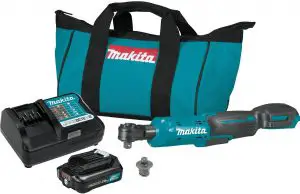 At a price of $189, the most expensive brand we’ll be testing is made by Makita. The tool is made in China, battery cell made in Japan, further processing in China. The charger is made in China and so is the tool bag, one 2-amp hour battery. Battery charger the Makita can be used as both a 3/8-inch drive as well as a quarter inch. The Makita also has a trigger lock, 0 to 800 rpm, we’re going to test that. 35-foot pounds, overall length 13 and 7/16. The Makita can be used without the battery and uses a regular ratchet. The Pro Stormer and the Earthquake don’t have lights but the Milwaukee and the Makita do have them. The Makita’s light definitely seems brighter and has a better broadcast. The Makita weighs 1066 grams, 2 pounds, 5.6 ounces. The Makita is definitely the most balanced tool, with a 50% weight balance on each end of the tool. At only 80 decibels, the Makita is the quietest of all four brands. The Makita is 39.35 mm, the Milwaukee and Pro Stormer both have a smaller head size compared to the Makita so the Makita is the quietest at 80 decibels, Pro Stormer and Milwaukee 81 decibels, and Earthquake – 86 decibels. The Makita is also the most balanced tool with the 50%-50% weight distribution, but the Milwaukee is nearly as good at 47% and 53%. Since the Pro Stormer is light, it feels about the same as the Milwaukee with its 56%-44% weight distribution. The length of the Earthquake along with the weight distribution definitely makes a very noticeable difference when you compare to the other three brands.
At a price of $189, the most expensive brand we’ll be testing is made by Makita. The tool is made in China, battery cell made in Japan, further processing in China. The charger is made in China and so is the tool bag, one 2-amp hour battery. Battery charger the Makita can be used as both a 3/8-inch drive as well as a quarter inch. The Makita also has a trigger lock, 0 to 800 rpm, we’re going to test that. 35-foot pounds, overall length 13 and 7/16. The Makita can be used without the battery and uses a regular ratchet. The Pro Stormer and the Earthquake don’t have lights but the Milwaukee and the Makita do have them. The Makita’s light definitely seems brighter and has a better broadcast. The Makita weighs 1066 grams, 2 pounds, 5.6 ounces. The Makita is definitely the most balanced tool, with a 50% weight balance on each end of the tool. At only 80 decibels, the Makita is the quietest of all four brands. The Makita is 39.35 mm, the Milwaukee and Pro Stormer both have a smaller head size compared to the Makita so the Makita is the quietest at 80 decibels, Pro Stormer and Milwaukee 81 decibels, and Earthquake – 86 decibels. The Makita is also the most balanced tool with the 50%-50% weight distribution, but the Milwaukee is nearly as good at 47% and 53%. Since the Pro Stormer is light, it feels about the same as the Milwaukee with its 56%-44% weight distribution. The length of the Earthquake along with the weight distribution definitely makes a very noticeable difference when you compare to the other three brands.
In the next test let’s measure the no load rpm for each ratchet. The Pro Stormer battery is fully charged – the Pro Stormer claims to make 230 rpm but actually did better than advertised at 319. The Earthquake’s battery is fully charged – the Earthquake is advertised as being capable of 170 rpm but actually did better than that at 256. Earthquake does a terrific job at slower speeds too, reaching as low as 30 rpm. The battery in the Milwaukee is fully charged – the Milwaukee provides the best low rpm control yet at only 15, it also produces the highest rpm at 490. The Makita which is advertised as being capable of 800 no load rpm but unfortunately, mine only produced 361 which isn’t nearly as fast as the Milwaukee. The minimum rpm was 39, so the Milwaukee came in on top for producing the most rpm, followed by Makita, then the Pro Stormer, and finally the Earthquake.
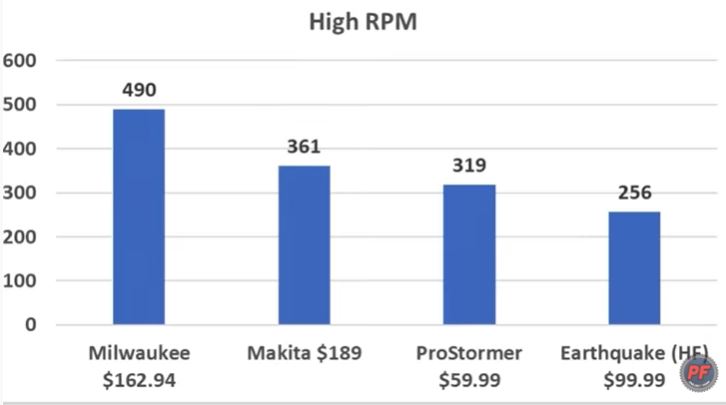
From the time the trigger or paddle is squeezed until the time the tool goes to work is called trigger delay, so let’s do a side-by-side comparison. With the Earthquake on the left and the Pro Stormer on the right, they’re actually pretty close. Let’s slow things down a little and the Pro Storm is slightly faster off the line, but the Earthquake has a much better break. Let’s compare the Pro Stormer to the Milwaukee: and the Pro Stormer is barely faster than the Milwaukee but the Milwaukee is definitely faster off the line than the Earthquake. Neither the Milwaukee nor the Pro Stormer come to a stop quickly like the Earthquake. And the Pro Stormer is actually a fraction of a second faster than Makita but it’s very close. Makita does have an electronic brake which allows it to stop quickly, so the Pro Stormer has the best trigger speed, but the Milwaukee and Makita make more rpm.
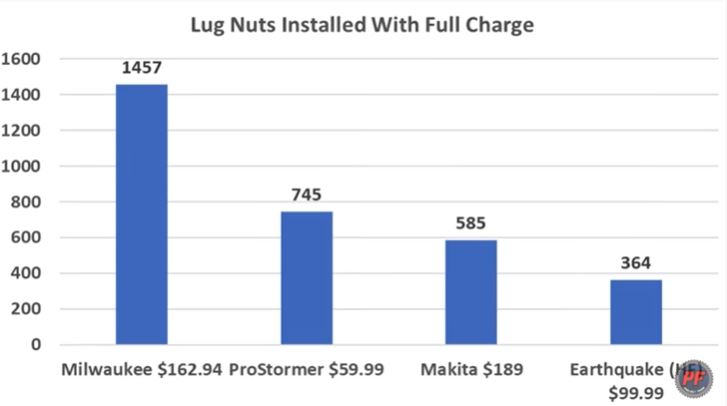
So, let’s see which can spin the 28 lug nuts on the fastest in the next test, beginning with the Pro Stormer. 1 minute and 52 seconds for the Pro Stormer which is right at four seconds per lug nut.
Let’s test the Earthquake: the battery is fully charged – the Earthquake is noticeably slower than a Pro Stormer, and also seems to make a lot more vibration as well. 2 minutes and 9 seconds for the Earthquake, which is a little over a half a second per lug nut slower than the Pro Stormer.
The Milwaukee battery is fully charged – and Milwaukee is noticeably faster than a Pro Stormer and the Earthquake. Wow, 1minute and 22 seconds for the Milwaukee, which is nearly a minute faster than the Earthquake.
The Makita’s battery is fully charged – just like the Milwaukee, the Makita is very fast: 1 minute and 27 seconds from Makita, which is five seconds slower than the Milwaukee.
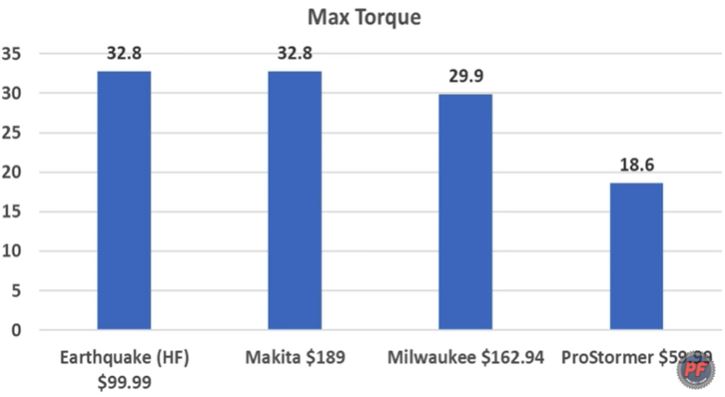
I put together this next test rig in order to measure the maximum torque of each brand. The nuts are welded in position but the bolt still rotates freely. I’ll use an electronic torque adapter, which will measure the maximum torque. 18.6 foot-pounds for the Pro Stormer, not bad for a budget tool. Testing the Earthquake next, 32.8 foot-pounds for the Earthquake. Testing to Milwaukee: 29.9 pounds for Milwaukee, not bad considering it’s geared for a much higher rpm and it’s a very compact tool. The Earthquake is in the lead at 32.8-foot pounds. 32.8 foot-pounds for Makita so the Earthquake and Makita are tied. For the lead sort of torque is a huge factor for you, the Makita and the Earthquake tied for first at 32.8 but Milwaukee wasn’t too far behind at 29.9 and the Pro Stormer finished in a distant fourth at 18.6.
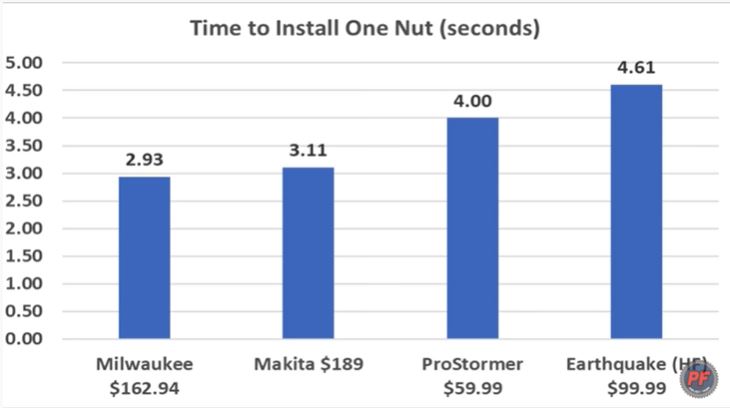
The purpose of this next test is to demonstrate the ability of these ratchets to remove a nut from a bolt with slightly rusted or damaged threads. We’ll keep an eye on the green rope to count the total rotations in this 30 second test. I went ahead, remove the spark plug, but i left the engine break in position which is providing right at 4.3 foot-pounds of resistance. The Pro Stormer are spinning the engine over just fine, but the load has really slowed it down so the Pro Stormer spun the engine over 38 times in 30 seconds. The Earthquake is off to a great start and is definitely spinning the engine over quite a bit faster than the Pro Stormer. Unfortunately, the Earthquake gave up at 23 seconds and couldn’t get going again. 57 rotations for the Earthquake. Milwaukee seems unfazed by the 4.3-foot pounds of resistance and is spinning the engine over quickly, 101 rotations in 30 seconds, very impressive. And the Makita definitely started off faster than Milwaukee but it slowed down a little around 17 seconds into the test. It barely finished ahead of the Milwaukee at 104 rotations.

In the next test we’ll find out if using ratchets manually to loosen really tight fasteners will cause damage. I’ll first tighten all the lug nuts to 90 foot-pounds and then let’s use the torque adapter to figure out our breakaway torque. It took 77.6 foot-pounds of torque to break loose the first lug nut, 77.4 for the second which is quite a bit for a 3/8-inch ratchet. And the Pro Stormer did just fine on the first lug nut, it also did just fine in the second, there’s no apparent damage. With the longer handle, the Earthquake offers quite a bit more leverage and didn’t have a problem removing both of the lug nuts. With a much shorter handle and a lot less leverage, it definitely took more effort but the Milwaukee held up just fine removing both of the lug nuts. The Makita’s longer handle definitely provided more leverage and it made easy work of both of the lug nuts.

Went ahead and fully drained all the batteries so let’s see how long it takes to charge them. All the brands use a 2-amp hour battery except for the Milwaukee which uses a 4-amp hour battery, so it’s definitely not a fair test since the Milwaukee has twice the storage capacity, but it’ll provide us with some great information. And the Makita is the first one fully charged at 61 minutes and 29 seconds, not bad for a fully drained battery. And the Pro Stormer took quite a bit longer at 74 minutes which is very close to 13 minutes longer than the Makita. The Milwaukee took 79 minutes and 30 seconds to charge a 4-amp hour battery, that’s actually pretty impressive. And the Earthquake took by far the longest at 91 minutes and 35 seconds.

All right the batteries are fully charged so let’s see how long the tools will run without a load. In addition to being able to lock the trigger on the Makita to keep it from accidentally powering up, it also powers itself off after one minute of continuous use, so I’ll have to hold the Makita and power it up once every minute. Unfortunately, the Earthquake which has the longest charge time at over an hour and a half also has the shortest run time at just under 28 minutes. It also has the slowest rpm and we’ll see how that impacts things. After 28 minutes of runtime all the tools are pretty hot, but not to the point of causing damage. The Makita which runs at a much higher rpm than the Earthquake is finished at just over 30 minutes. The Pro Stormer did a pretty impressive job at 49 minutes and 40 seconds, which is very close to 19 more minutes of run time compared to the Makita. The Milwaukee, as expected with its 4-amp hour battery, totally crushed the competition at 71 minutes and 20 seconds. Rpm and battery life both have a huge impact on how much work you can get done on a full charge.
So going back to our test setup that had 28 lug nuts, the Milwaukee ratchet installs a lug nut every 2.93 seconds. Makita needed 3.11 seconds, Pro Stormer: 4 seconds, and Earthquake: 4.61. Assuming the threads are well lubricated, the Milwaukee could install around 1457 lug nuts in a single charge under perfect conditions. The Pro Stormer could install 745, the Makita 585, and the Earthquake 364. While we don’t know the number of charge and discharge cycles for each battery, the Earthquake battery is going to have to be charged a lot more often than the other brands and is likely to wear out a lot sooner.






